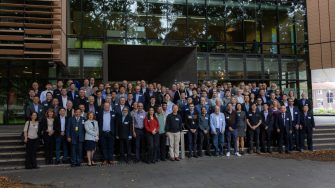
Innovators, energy leaders and experts from around the world recently gathered at UNSW Sydney to commemorate a groundbreaking milestone in renewable energy storage: the 40th anniversary of the invention of the Vanadium Flow Battery (VFB).
The event, spearheaded by Emeritus Professor Maria Skyllas-Kazacos, whose pioneering work led to the creation of VFB technology, was both a celebration of the technology’s past achievements and a forward-looking discussion on its role in decarbonisation and the future of global energy storage.
Prof. Skyllas-Kazacos delivered a captivating keynote talk, taking attendees on a journey through the decades of development, from the earliest 1-kilowatt vanadium flow battery experiments to today's large-scale installations designed to store gigawatt-hours of electricity. Her reflection was infused with both humour and nostalgia, recounting the highs and lows of innovation as part of a marathon of collaborative efforts.
Mining giant Rio Tinto shared insights into its ambitious decarbonisation goals, spotlighting VFB technology as a key player in repowering its Pacific operations and providing renewable energy solutions for on-grid and off-grid mining sites in regions such as Iceland, South Africa and Oman.
On the global stage, Ao Tang from the Chinese Academy of Sciences outlined China’s commitment to long-duration energy storage, with its technology focus having been formally declared as pumped hydro, compressed air and VFBs. He provided updates on China’s progress in manufacturing automation and cost reduction for VFB, with GWh-scale installations and production facilities currently under development.
The symposium also showcased the expanding global footprint of VFB technology. Sumitomo Electric presented its impressive 60MWh and 51MWh installations for Japan’s Hokkaido Electric, while UK- and Canada-based Invinity Energy Systems highlighted its notable 8MWh installation in South Australia, part of over 1,200 VFB installations worldwide.
The symposium also highlighted the fact that the flow battery’s development is far from over. Researchers at UNSW, led by Professor Jie Bao and Associate Professor Chris Menictas, continue to push the boundaries of this technology.
Their cutting-edge work focuses on enhancing the battery’s efficiency and economics, supporting the growing global demand for reliable, long-duration energy storage.
Australian companies also played a central role, emphasising the unique potential for a fully domestic VFB supply chain - from vanadium oxide and electrolyte production to battery manufacturing and installation. Discussions centered on the future of local manufacturing and the opportunities it presents for Australia to lead the charge in long-duration energy storage technology.
In a rapidly decarbonising world, the flow battery stands out as a critical solution among a diverse array of technologies. Other flow battery chemistries are also emerging, broadening the spectrum of solutions available for long-duration energy storage needs.
The event concluded with an inspiring takeaway: the vanadium flow battery, once a breakthrough confined to research labs, has now firmly entered the realm of commercial success. What began as a groundbreaking invention at UNSW four decades ago, is now a critical component of large-scale energy storage projects worldwide.
As the symposium showcased, this technology is already transforming industries today, from large-scale renewable energy installations in Japan and South Australia, to decarbonisation opportunities for global mining companies like Rio Tinto. The conversations around scaling domestic production and deploying VFBs globally signal that the technology is poised for even broader adoption.
Attendees left with a clear message: the decade will see the deployment of flow battery technology at scale in Australia and around the world, helping to power a more sustainable, decarbonised global future and allowing the flow battery to take its rightful place in the Australian history books.
